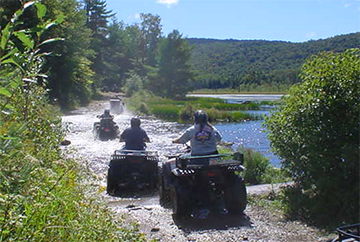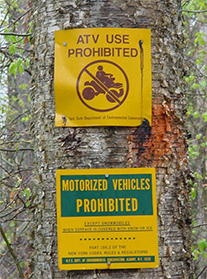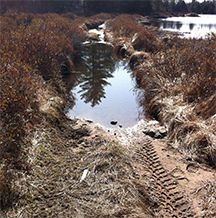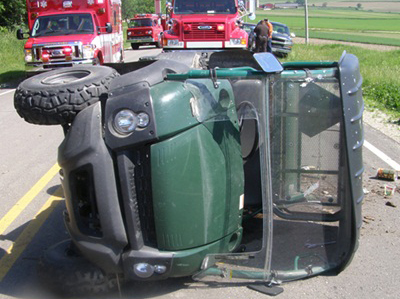
"Lingchi" - Why we need All-Terrain Vehicle Reform Now
Tuesday, December 20, 2016
By Kevin Chlad - Adirondack Council - Director of Government Relations
“Lingchi” or “death by a thousand cuts” was once a gruesome act that now stands as a metaphor, encouraging all of us to be wise in  considering cumulative impacts of any given activity. Simply put, an action that seems rather insignificant on its own may be devastating when replicated many times over. When I think about All Terrain Vehicle (ATV) use in New York State, I remember “Lingchi.”
considering cumulative impacts of any given activity. Simply put, an action that seems rather insignificant on its own may be devastating when replicated many times over. When I think about All Terrain Vehicle (ATV) use in New York State, I remember “Lingchi.”
Our public lands, our public roads and our public health continue to play host to a litany of “tiny cuts” that when viewed as a whole paint a very clear picture that shows why we must enact broad reforms to ATV legislation in this legislative session.
Our Public Lands
 In the last two years, our state has expanded motorized use of our public lands in ways that may seem inconsequential, or even insignificant, but when viewed at a macro-level, demonstrate a trajectory that we should all find concerning. The Recreation Management Plan for the Kushuqua Conservation Easement, located in south-central Franklin County adjacent to the Debar Mountain Wild Forest, opened up 30 miles of roads on the property to seasonal ATV use. The St. Lawrence Flatlands Unit Management Plan (UMP), which provides an essential wildlife migration corridor between the Adirondacks and Canada, opened ATV riding opportunities on lands where trails had already been closed due to misuse once before. And now the UMP for the Grass River Wild Forest in the Northwest Adirondacks is currently being looked at for an ATV trail linkage, reversing course from the Department of Environmental Conservation’s recent history of keeping ATV travel off our constitutionally protected “forever wild” lands.
In the last two years, our state has expanded motorized use of our public lands in ways that may seem inconsequential, or even insignificant, but when viewed at a macro-level, demonstrate a trajectory that we should all find concerning. The Recreation Management Plan for the Kushuqua Conservation Easement, located in south-central Franklin County adjacent to the Debar Mountain Wild Forest, opened up 30 miles of roads on the property to seasonal ATV use. The St. Lawrence Flatlands Unit Management Plan (UMP), which provides an essential wildlife migration corridor between the Adirondacks and Canada, opened ATV riding opportunities on lands where trails had already been closed due to misuse once before. And now the UMP for the Grass River Wild Forest in the Northwest Adirondacks is currently being looked at for an ATV trail linkage, reversing course from the Department of Environmental Conservation’s recent history of keeping ATV travel off our constitutionally protected “forever wild” lands.
For some reason, these actions have been carried out, in spite of the state’s long demonstrated challenges with keeping ATV use a sustainable activity. The 2011 NYSDEC Strategic Plan for State Forest Management details the inappropriate nature of recreational ATV riding on our state-owned lands:
Environmental impacts from ATV and OHV use include soil erosion, displacement and compaction, direct impacts to streams and wetlands from ATV crossings, including increased siltation and turbidity, noise, disturbance to wildlife and their habitats, damage to vegetation, and air pollution. ATV use impacts neighboring landowners and conflicts with other recreational pursuits.
Illegal use of ATVS and OHVs on State Forest roads and trails officially closed to ATV and OHV use is frequent, difficult to prevent, and presents significant enforcement issues. Despite a variety of signs, gates, boulders, and other barriers designed to notify ATV and OHV users that particular roads and trails are closed to their use, a large amount of illegal riding continues to occur on these prohibited areas…
The environmental impacts (including noise), intensity, and nature of both legal and illegal ATV use has been shown to cause other recreational uses to decline and in some cases completely cease, once an area is opened for ATV use.
Over the years, attempts have been made to accommodate off highway and all terrain vehicle use on several State Forests but in each case, the use was not sustainable. Serious issues with soil erosion, illegal off-trail use and rutting developed. In all cases DEC was not able to find acceptable ways to mitigate the impacts, even when organized user groups were included in the process. In the end, each of the former off-road vehicle trail systems was closed.
(NYSDEC Strategic Plan for State Forest Management, Pg 213)
|
Our Public Roads These “tiny cuts” are not only taking place on our public lands. New York is one of 38 states in which roads can legally be opened to ATV use. Inappropriate road openings expose state and private lands to the risks of trespass and associated impacts which have been widely documented, and also posed risks to the safety of residents, pedestrians, and automobile operators when ATVs are operated in an unsafe manner. These challenges are a direct threat to community vibrancy. On an annual basis, many town and county roads are opened up to ATV use in New York, and evidence demonstrates that these openings have failed to follow the letter and spirit of the law on many occasions. In New York, a town or county can open a road to ATV use in order to connect two legal ATV riding areas. That can only be done when it has been proven that it is “otherwise impossible” for a rider to get between those two locations, and that the action will not have an adverse impact on the environment. Misuse of this legislation can and has led to the creation of full-scale trail systems located on road right-of-ways. The misinterpretation or misuse of this “roads law” motivated the New York State Attorney General to issue an opinion in 2005: …we note that a local law opening designated highways to ATV use must be supported by a determination that “it is otherwise impossible for ATVs to gain access to areas or trails adjacent to the highway” without use of the designated roads. Without such findings, the local law would be considered invalid. Further, we conclude that town highways may not be considered “trails” for the purposes of Vehicle and Traffic Law §2405, as this would be contrary to the State Legislature’s intent to confine ATV use primarily to off-highway pathways. (NYSOAG Informal Opinion 2005-21, pg 2) Unfortunately, these road openings have occurred at a frequency that makes it impossible for any citizen or advocate to completely halt the misuse of this law by running to the courts every time it happens, and so more and more roads continue to be opened to ATV use. But here’s the kicker: ATV manufacturers advise the owners of their vehicles to avoid operating their machines on hardened surfaces, such as roads. The user manual for the 2014 Polaris Razr 570 provides an example of the language that can be found in virtually any ATV user manual: This vehicle's tires are designed for off-road use only, not for use on pavement. Operating this vehicle on paved surfaces (including sidewalks, paths, parking lots and driveways) may adversely affect the handling of the vehicle and may increase the risk of loss of control and accident or rollover. Avoid operating the vehicle on pavement. If it's unavoidable, travel slowly, travel short distances and avoid sudden turns or stops. 2014 Polaris Razr 570 User Manual, Page 17
Our Public Health The learning curve for operating an ATV is steep, as these machines require physical strength and finesse to operate in a safe manner. Yet in New York, a 10 year old can legally operate an ATV in an unsupervised manner, with the appropriate certification. There is no question that a young man or woman at that age can learn to operate an ATV to the extent that they can pass a test, but it seems perfectly fair to question whether they have developed the necessary judgement one should have when operating on a road with automobile traffic. And this is where the topic becomes truly heartbreaking. In April 2015, the Oneonta Daily Star reported that an 11 year old boy was seriously injured in an ATV accident. His nine year old brother was also on the machine, but was luckily uninjured. In September of 2013, the Telegram in Mohawk, NY reported that an 11 year old girl lost her hand when the UTV she was operating rolled over. The 5 and 12 year old children that were riding with her were uninjured. In late August of this year, the Watertown Daily Times reported that two children and one adult were injured in two separate accidents on the same day. Both accidents occurred on roads. Sadly, these examples go on and on and on. Believe it or not, ATV use has also become a challenge in New York City, particularly in the Bronx and Manhattan. While ATV riding is not permitted in the five boroughs, groups of riders are now acquiring machines and storing them in shipping containers or storage lockers, waiting for opportunities to sneak out and ride around the streets of New York City. A November 18, 2013 article from The New York Times reported on the recent uptick in vehicular crimes involving ATVs and dirt bikes, highlighting that in the Bronx alone, “…more than 200 cases – including reckless driving, vehicle violations and, in a few instances, striking pedestrians – [occurred in] this summer alone.” More recent news stories indicate that this situation has not yet improved. All of the sudden, these “tiny cuts” don’t seem so tiny. The Silver Lining New York is a state we should all be proud of… it’s a state that’s teeming with life. Whether you’re standing on Broadway in New York City watching humans rush about their daily business, or bushwhacking in the Pepperbox Wilderness in the western Adirondacks and you stir up a moose, you will bear witness to the miracles of life, though quite contrasting in their respective forms. Our State, for all intents and purposes, is a life form that can be kept healthy and vibrant, if we take care of it and remain wary of “tiny cuts” that may seem innocuous when we lose track of the bigger picture. But it’s important to take note that we can have ATV riding, if we do not allow our state to be vulnerable to its impacts. New York state could pursue reform with a general ban on riding on “forever wild” and sensitive state lands, coupled with safe places to ride on private and easement lands, and enhancements to safety, enforcement and compliance. So, as New Yorkers, will we accept “lingchi?” Will we stand by and watch these “tiny cuts” continue, and risk snuffing out that which makes our state so vibrant? If you answer by saying, “no,” then I have good news. Our New York State Government can do something about this. |
|
|||

 Furthermore, the 2015 NYS Ranger Report states, “Continuing a trend of the last two decades, the most problematic activity encountered by Rangers was the illegal use of all-terrain vehicles….” While recent actions by the state to permit ATV use on state lands may seem as though they are not likely to have an adverse impact on the environment, one must ask, will this collections of actions, and the demonstrated intent of the state, have a negative impact on the environment? Will we continue to accept these “tiny cuts?”
Furthermore, the 2015 NYS Ranger Report states, “Continuing a trend of the last two decades, the most problematic activity encountered by Rangers was the illegal use of all-terrain vehicles….” While recent actions by the state to permit ATV use on state lands may seem as though they are not likely to have an adverse impact on the environment, one must ask, will this collections of actions, and the demonstrated intent of the state, have a negative impact on the environment? Will we continue to accept these “tiny cuts?” ATV tires operate on low pressures (8-10 psi) in order to gain traction on off road surfaces, and that leaves the machine prone to rollovers. This has been the subject of extensive studies by the Consumer Product Safety Commission. Even with direction from the Attorney General and advice from the manufacturers, will we decide to continue accepting these “tiny cuts?”
ATV tires operate on low pressures (8-10 psi) in order to gain traction on off road surfaces, and that leaves the machine prone to rollovers. This has been the subject of extensive studies by the Consumer Product Safety Commission. Even with direction from the Attorney General and advice from the manufacturers, will we decide to continue accepting these “tiny cuts?”



